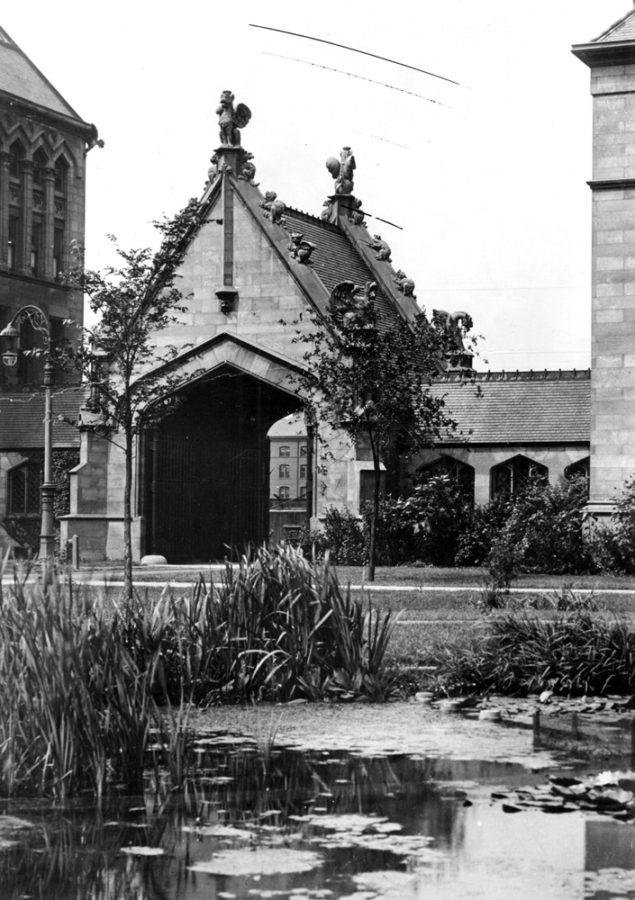[img id=”77209″ align=”alignleft”] You can’t just go around changing the names of world-class business schools.
The lawn at the Graduate School of Business—that is, the GSB—doesn’t see a whole lot of action. At other schools, gently sloping, emerald-green lawns are a kind of second home to students: reading, sleeping, listening to music, talking in circles, playing hackysack, and generally being the sort of archetypal college students that appear on the cover of every school’s admissions packet. Here, on those few days when the grass is not covered in a layer of gritty ice that the wind picks up and hurls at passersby at the slightest provocation, no one—not undergrads, not Labbies, not harassed-looking business students frantically striding around in suits—sets foot on the grass. Indeed, the lawn’s only company is the massive silver sign marking the edifice as the GSB. Or it was, at least, until November 6.
It was on November 6 that alumnus David Booth’s record-smashing $300 million donation to the GSB was announced. The gift is to be used to woo prominent would-be faculty members and develop international programs, and has no strings attached. None, that is, save one: The GSB is dead. The sun rose that November day on the GSB and set instead on the University of Chicago Booth School of Business, and the sign was replaced to mark the switch.
Nearly three months later, most students seem mildly troubled by the name change, and it doesn’t help matters that no one knows what exactly they should be calling the thing. While the University has been pushing wholeheartedly for “Chicago Booth”—sweatshirts branded as such were ready to go on the night of the donation’s announcement—students mostly hover between “the Booth school” and “the BSB.” Others have dismissed the switch altogether, steadfastly refusing to call the GSB anything else than what it has always been. Everyone else is vaguely apologetic about the whole thing, hurrying through any mention of the school and shrugging at listeners as if to say, “I know, I know. The GSB. Just play along.”
And there are other questions. What if the general manager at Toys ‘R’ Us—the apocalypse might not have investment banks, but it will probably still have toys—doesn’t know what the line that says “Chicago Booth” on your résumé is supposed to mean? Perhaps the people at Toys ‘R’ Us will think that it was an online program or some lesser suburban academy, or maybe just some kind of booth somewhere in the Windy City that emits little slips of paper that say “M.B.A.” Maybe there should there be an asterisk, a little ahem, to say, oh, you know, the famous one, with all those famous professors and theories—right, and the donation.
There is, in fact, a Chicago booth. It’s about the size of a person and stuck squarely in the middle of the driveway leading out of the parking lot underneath the GS—er, Booth, and helps keep the parking attendant safe from the icy horrors of Chicago. The booth is maroon, as all good things are, and proudly bears the emblem “Chicago Booth.” It’s no one’s fault that the donor at large shares his last name with a common noun, but there it is: It’s a Chicago booth.
So what, then, is in a name? What is Chicago Booth if no one knows what it is, if it can simultaneously refer with no obvious distinction to one of the greatest business institutions in the world and a hut that keeps one man warm?
This is a school that has famously struggled to find a way to give itself a name that more than five percent of the population will know—some lasso to tie together Milton Friedman and nuclear reactions and sociology and the press, something to put on sweatshirts that doesn’t make the Office of College Admissions cringe, somewhere for alumni like David Booth to emblazon their generous gifts on plaques and oversized signs on lawns. The name change and the cost of scraping off the GSB’s name from every frosted-glass surface on campus are not the caveat of an alumnus. Rather, this the U of C taking the advice dispensed in every elementary business class: Make yourself into a brand.
So yes, students are confused and have new e-mail addresses and business cards, and the lawn has a new sign. But with $300 million and the chance to create a name for a graduate school at a chronically obscure university, it might just be worth it.







